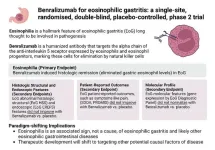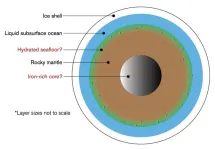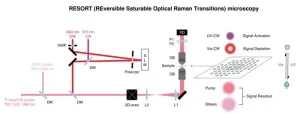(Press-News.org) The good news: a monoclonal antibody treatment called benralizumab proved quite effective in a clinical trial at depleting the number of eosinophils found in the blood and digestive tract tissues of patients with eosinophilic gastritis.
The not-so-good news: eliminating eosinophils was not enough to stop the symptoms people feel with this uncommon and severe form of food allergy. Nor did the treatment affect key measures of gut tissue health and related gene expression patterns.
These paradigm-shifting Phase 2 clinical trial results were published online June 16, 2023, in The Lancet Gastroenterology & Hepatology.
“Our findings suggest that the mechanisms driving this disease are in large part independent of excessive eosinophil production. That means our attention should turn towards other therapeutic targets to find curative treatments and that how we define remission for this disease should be reconsidered,” says Marc Rothenberg, MD, PhD, corresponding author for the study and one of the world’s foremost authorities on eosinophilic gastrointestinal disorders (EGID).
Rothenberg directs the Division of Allergy and Immunology at Cincinnati Children’s. He also leads the Cincinnati Center for Eosinophilic Disorders (CCED) at Cincinnati Children’s and serves as principal investigator and co-leader of the national Consortium of Eosinophilic Gastrointestinal Disease Researchers (CEGIR).
Rothenberg has devoted decades to studying and treating children living with this collection of severe inflammatory reactions to otherwise common foods. For many, the allergic reactions are so strong that they must follow extremely strict and limited diets. The eating difficulties can limit growth and lead to other longer-term complications.
What are EGIDs?
EGIDs have been distinguished from other food allergies because symptoms typically do not occur immediately after consuming the offending food. Patients with EGID have abnormally high levels of eosinophils in their digestive tract tissues. Eosinophils are one of several types of white blood cells that are part of our normally protective immune system. But they occur in high amounts in certain diseases such as EGID and asthma. In the case of asthma, eosinophils can promote excessive inflammation and tissue damage and reducing their levels can have substantial clinical benefit. But the exact role of eosinophils in EGID has not yet been determined.
Eosinophilic esophagitis (EoE) is the most common EGID, affecting an estimated 1 in 2,000 people (or about 166,000 people in the US). Less than 50,000 people in the US, combined, are believed to have other EGIDs including eosinophilic gastritis, eosinophilic enteritis, and eosinophilic colitis.
Over the years, eosinophil counts have emerged as the key biomarker for tracking the severity of EGID. Pharmaceutical companies also have been testing new and existing biologics and other treatments for their ability to reduce eosinophil counts. Benralizumab, made by AstraZeneca, is one such drug, as it safely removes eosinophils from the body and is now approved therapy for severe asthma associated with eosinophils.
Mixed results for eosinophil-depleting drug.
The study conducted by Kara Kliewer, PhD, Rothenberg, and their colleagues involved 26 patients with active eosinophilic gastritis disease, ages 12 to 60, who were randomly assigned to receive either the treatment drug or a placebo. Participants received three injections each across 12 weeks.
Of the 13 who received the drug, 10 achieved technical “remission.” That means the number of eosinophils in their blood and stomach dropped substantially, in fact, almost to zero.
However, there were no statistically significant differences in symptoms including pain, endoscopic findings, quality of life scores, or other measures reported between the drug and placebo groups. Although structural tissue abnormalities improved for six of the 13 drug-treated participants, they worsened or remained the same for the other seven. Meanwhile, an analysis of 48 genes known to be affected by eosinophilic disorders showed no improvement in abnormal expression patterns.
“These findings provide compelling evidence for a changed paradigm, shifting attention away from eosinophils as the main contributor and biomarker in eosinophilic gastrointestinal diseases,” says Kliewer. “Thus, successful management of eosinophilic gastritis may require inhibiting pathways that more broadly reduce type 2 inflammation rather than only targeting eosinophils.”
What does this mean for patients and families?
Mostly, these results suggest that patients will have to wait longer for improved treatments to be developed for eosinophilic gastritis, Rothenberg says. However, our Cincinnati Children’s research team’s multiprong research approach means that several other treatment avenues were already being pursued in parallel to eosinophil-depleting possibilities.
Current standard treatments, such as diet management, anti-inflammatory steroid medications and pain relievers, should continue. If patients are receiving off-label treatments with IL-5 blockers (eosinophil-depleting drugs), they are not likely to see significant benefits, Rothenberg says.
Families with specific questions are encouraged to contact the specialist managing their child’s care.
Next steps
Researchers are likely to shift their focus to intensify studying therapies that act against other aspects of eosinophilic disease.
In 2022, the US Food and Drug Administration approved the use of dupilumab—a drug already approved for treating eczema and asthma--as the first treatment specifically approved in the US for EoE. This drug, also a monoclonal antibody, blocks interleukin-4 and interleukin-13 signaling, thus targeting type 2 inflammation rather than just eosinophils.
Rothenberg was a co-first author of the study that laid out the Phase 3 clinical trial results, which were published in The New England Journal of Medicine. The symptom improvement seen in dupilumab- treated patients with EoE suggests that it may also work for the other less common forms of EGID. Through CEGIR, Rothenberg and other national experts are currently testing the theory that dupilumab may be beneficial for other forms of EGID, such as eosinophilic gastritis.
Meanwhile, Rothenberg says CEGIR is using the current findings to revise practice guidelines for EGID treatment so that they rely less heavily on eosinophil counts as a biomarker.
“Many people had high hopes that depleting eosinophils would make a large impact on EGIDs, but this is why clinical trials are so important,” Rothenberg says. “Even when results are disappointing, we learn from them and that allows us to move on to other potential approaches to improve outcomes.”
About this study
In addition to Rothenberg, Cincinnati Children’s co-authors for this study included first author Kara Kliewer, PhD, Cristin Murray-Petzold, BS, Margaret Collins, MD, Juan Abonia, MD, Scott Bolton, MD, Lauren DiTommaso, BS, Lisa Martin, MD, Xue Zhang, MD, Vincent Mukkada, MD, Philip Putnam, MD, Erinn Kellner, MD, Ashley Devonshire, MD, Justin Schwartz, MD, Chen Rosenberg, MD, John Lyles, MD, and Tetsuo Shoda, MD.
Co-authors also included Vidhya Kunnathur, MD, from the University of Cincinnati College of Medicine, and Amy Klion, MD, with the National Institute of Allergy and Infectious Disease (NIAID).
This study was funded primarily by AstraZeneca.
END
Wider search needed to improve outcomes for eosinophilic food allergy
Clinical trial results indicate that high eosinophil cell counts reflect a major sign of disease vs. primary cause, according to experts at Cincinnati Children’s
2023-06-17
ELSE PRESS RELEASES FROM THIS DATE:
University of Montana science unlocks secrets of high-elevation pregnancies
2023-06-17
MISSOULA – Pregnancy at high elevations often is associated with low birth weights and other complications. These challenges occur in a wide range of mammals, from deer mice to human beings.
Research conducted at the University of Montana revealed some of the genetic underpinnings that allow certain highland mouse populations to protect developing fetuses in higher areas. The work was published recently in the Proceedings of the National Academy of Sciences.
“Understanding how deer mice survive and thrive at high elevations not only informs our understanding of basic evolutionary processes, it may also one ...
ASU study: Jupiter’s moon Europa may have had a slow evolution
2023-06-16
Jupiter's moon, Europa, is slightly smaller than Earth’s Moon and is one of the most promising places to search for alien life.
Amid the Jovian system, Europa is of particular interest to scientists because of the strong evidence for nutrients, water and energy to potentially provide a habitable environment for some form of life beyond Earth. In addition, Europa is believed to be made up into four layers (from surface to center): an ice shell, salt water ocean, rocky mantle, and metallic core.
Like Earth, Europa’s ...
Adagrasib effective for patients with KRAS G12C-mutant lung cancer and untreated brain metastases
2023-06-16
HOUSTON ― Researchers from The University of Texas MD Anderson Cancer Center found the KRAS G12C inhibitor adagrasib showed promising activity suppressing cancer growth not only within the lungs but also in brain metastases for patients with KRAS G12C-mutated non-small cell lung cancer (NSCLC).
Findings from the Phase Ib cohort of the KRYSTAL-1 trial, published today in the Journal of Clinical Oncology, represent the first prospective data of anti-tumor activity from a KRAS G12C inhibitor in brain metastases, providing continued evidence of the ...
ACQUIRE therapy framework shows results for intensive pediatric rehabilitation
2023-06-16
Virginia Tech researchers with the Fralin Biomedical Research Institute at VTC have demonstrated that children with a wide range of diagnoses that affect their motor function improve after receiving intensive pediatric neurorehabilitation called ACQUIRE Therapy.
The findings were published in June in Behavioral Sciences and will be included in an upcoming special issue of the journal devoted to “shifting the therapeutic paradigm for children with neuromotor disabilities to maximize development.”
“We ...
New research shows HIV can lie dormant in the brain
2023-06-16
As a part of its life cycle, the human immunodeficiency virus-1 (HIV) inserts a copy of its DNA into human immune cells. Some of these newly infected immune cells can then transition into a dormant, latent state for a long period of time, which is referred to as HIV latency.
Although current therapies, such current antiretroviral therapy (ART), can successfully block the virus from replicating further, it cannot eradicate latent HIV. If treatment is ever discontinued, the virus can rebound from latency and reignite the progression of HIV infection to AIDS.
Scientists from the HIV Cure Center at the UNC School of Medicine, University of California ...
For resistant breast cancers, two drugs may be better than one
2023-06-16
Cancer cells are even smarter than scientists previously believed, according to new CU Boulder research. When these cells are confronted with potent new drugs called CDK2 inhibitors, which are designed to prevent cancer from proliferating, they can trigger a workaround to survive the assault in as little as one to two hours.
But the study, published June 8 in the journal “Cell,” comes with a silver lining.
It reveals how cancer cells complete this adaption and shows that simultaneously administering a second, already widely ...
UMass Amherst biostatistician developing statistical tools to predict breast cancer survival and inform targeted therapies
2023-06-16
Breast cancer is a complex disease, and its progression is difficult, yet important, to predict.
While many elements may contribute to a breast cancer prognosis, University of Massachusetts Amherst biostatistician Chi Hyun Lee has zeroed in on one risk factor that has emerged for its potential to predict the disease’s progression.
Lee will use a two-year, $154,791 grant from the National Institutes of Health (NIH) in an effort to develop statistical tools that will better predict breast cancer survival rates and survival time after breast cancer recurrence.
While the project focuses on breast cancer research, the proposed statistical ...
Jefferson Lab outreach efforts earn national recognition
2023-06-16
NEWPORT NEWS, VA – When the global pandemic put the kibosh on in-person events, the U.S. Department of Energy’s Thomas Jefferson National Accelerator Facility sought alternatives for ensuring its world-class science and unique equipment remained accessible. These efforts culminated in the Fall for Science Virtual Field Trip Event, which rolled out a virtual tour experience, new website, and unique supporting materials. Now, the event has been recognized by the Public Relations Society of America with three Anvil Awards.
According ...
Uncovering a cellular process that leads to inflammation
2023-06-16
Cedars-Sinai investigators have identified several steps in a cellular process responsible for triggering one of the body’s important inflammatory responses. Their findings, published in the peer-reviewed journal Science Immunology, open up possibilities for modulating the type of inflammation associated with several infections and inflammatory diseases.
Specifically, the investigators have improved understanding of the steps that lead to the production of IL-1 beta, a potent inflammatory protein signal released during many inflammatory responses.
“We now have a clearer understanding of the stepwise process that leads to the production of IL-1 beta,” said Andrea ...
New imaging technique is no last resort
2023-06-16
There are various ways to image biological samples on a microscopic level, and each has its own pros and cons. For the first time, a team of researchers, including those from the University of Tokyo, has combined aspects from two of the leading imaging techniques to craft a new method of imaging and analyzing biological samples. Its concept, known as RESORT, paves the way to observe living systems in unprecedented detail.
For as long as humanity has been able to manipulate glass, we have used optical devices to peer at the microscopic world in ever increasing ...
LAST 30 PRESS RELEASES:
Why nail-biting, procrastination and other self-sabotaging behaviors are rooted in survival instincts
Regional variations in mechanical properties of porcine leptomeninges
Artificial empathy in therapy and healthcare: advancements in interpersonal interaction technologies
Why some brains switch gears more efficiently than others
UVA’s Jundong Li wins ICDM’S 2025 Tao Li Award for data mining, machine learning
UVA’s low-power, high-performance computer power player Mircea Stan earns National Academy of Inventors fellowship
Not playing by the rules: USU researcher explores filamentous algae dynamics in rivers
Do our body clocks influence our risk of dementia?
Anthropologists offer new evidence of bipedalism in long-debated fossil discovery
Safer receipt paper from wood
Dosage-sensitive genes suggest no whole-genome duplications in ancestral angiosperm
First ancient human herpesvirus genomes document their deep history with humans
Why Some Bacteria Survive Antibiotics and How to Stop Them - New study reveals that bacteria can survive antibiotic treatment through two fundamentally different “shutdown modes”
UCLA study links scar healing to dangerous placenta condition
CHANGE-seq-BE finds off-target changes in the genome from base editors
The Journal of Nuclear Medicine Ahead-of-Print Tip Sheet: January 2, 2026
Delayed or absent first dose of measles, mumps, and rubella vaccination
Trends in US preterm birth rates by household income and race and ethnicity
Study identifies potential biomarker linked to progression and brain inflammation in multiple sclerosis
Many mothers in Norway do not show up for postnatal check-ups
Researchers want to find out why quick clay is so unstable
Superradiant spins show teamwork at the quantum scale
Cleveland Clinic Research links tumor bacteria to immunotherapy resistance in head and neck cancer
First Editorial of 2026: Resisting AI slop
Joint ground- and space-based observations reveal Saturn-mass rogue planet
Inheritable genetic variant offers protection against blood cancer risk and progression
Pigs settled Pacific islands alongside early human voyagers
A Coral reef’s daily pulse reshapes microbes in surrounding waters
EAST Tokamak experiments exceed plasma density limit, offering new approach to fusion ignition
Groundbreaking discovery reveals Africa’s oldest cremation pyre and complex ritual practices
[Press-News.org] Wider search needed to improve outcomes for eosinophilic food allergyClinical trial results indicate that high eosinophil cell counts reflect a major sign of disease vs. primary cause, according to experts at Cincinnati Children’s









